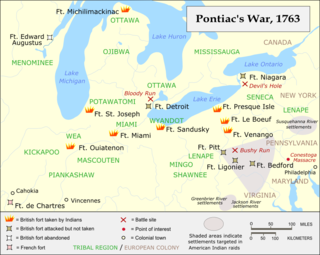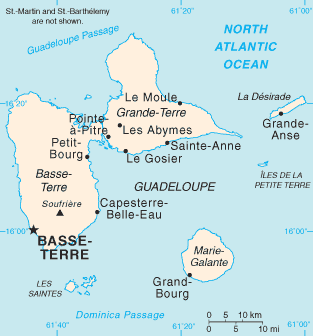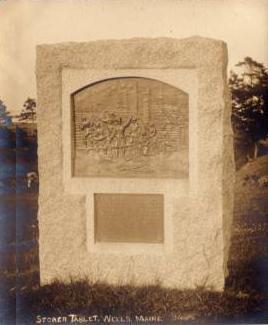
Fort William Henry was a British fort at the southern end of Lake George, in the province of New York. The fort's construction was ordered by Sir William Johnson in September 1755, during the French and Indian War, as a staging ground for attacks against the French position at Fort St. Frédéric. It was part of a chain of British and French forts along the important inland waterway from New York City to Montreal, and occupied a key forward location on the frontier between New York and New France. In 1757, the French general Louis-Joseph de Montcalm conducted a successful siege that forced the British to surrender. The Huron warriors who accompanied the French army subsequently killed many of the British prisoners. The siege and massacre were portrayed in James Fenimore Cooper's novel The Last of the Mohicans.

The Battle of Fort Beauséjour was fought on the Isthmus of Chignecto and marked the end of Father Le Loutre's War and the opening of a British offensive in the Acadia/Nova Scotia theatre of the Seven Years' War, which would eventually lead to the end of the French colonial empire in North America..

The Battle of Bloody Run was fought during Pontiac's War on July 31, 1763, on what now is the site of Elmwood Cemetery in the Eastside Historic Cemetery District of Detroit, Michigan. In an attempt to break Pontiac's siege of Fort Detroit, about 250 British troops attempted to make a surprise attack on Pontiac's encampment.

Fort Pontchartrain du Détroit or Fort Detroit (1701–1796) was a fort established on the north bank of the Detroit River by the French officer Antoine de la Mothe Cadillac and the Italian Alphonse de Tonty in 1701. In the 18th century, French colonial settlements developed on both sides of the river, based on the fur trade, missions, and farms.

The siege of Fort Detroit was an ultimately unsuccessful attempt by North American Indians to capture Fort Detroit during Pontiac's Rebellion. The siege was led primarily by Pontiac, an Ottawa chief and military leader. This rebellion would be one of the catalysts that hastened the declaration of the Proclamation of 1763 which would eventually precipitate the events leading to the American Revolution.

Beartown State Forest is a publicly owned forest with recreational features located in the towns of Great Barrington, Monterey, Lee, and Tyringham, Massachusetts. The state forest's more than 10,000 acres (4,000 ha) include 198 acres (80 ha) of recreational parkland. It is managed by the Massachusetts Department of Conservation and Recreation.

Governors Island was an island in Boston Harbor in the U.S. state of Massachusetts. The island was subsumed by land reclamation for the construction and extension of Logan International Airport.

The Battle of Port Royal occurred at Port Royal, the capital of Acadia, during King William's War. A large force of New England provincial militia arrived before Port Royal. The Governor of Acadia Louis-Alexandre des Friches de Menneval had only 70 soldiers; the unfinished enceinte remained open and its 18 cannon had not been brought into firing positions; 42 young men of Port-Royal were absent. Any resistance therefore appeared useless. Meneval surrendered without resistance not long after the New Englanders arrived. The New Englanders, led by Sir William Phips, after alleging Acadian violations of the terms of surrender, plundered the town and the fort.

Jonathan Eddy was a British-American soldier, who fought for the British in the French and Indian War and for the Americans in the American Revolution. After the French and Indian War, he settled in Nova Scotia as a New England Planter, becoming a member of the General Assembly of Nova Scotia. During the American Revolutionary War, he was strongly supportive of the rebellion against the Crown. He encouraged the residents of Nova Scotia to join in open revolt against King George III and England. He led a failed attempt to capture Fort Cumberland in 1776 and was forced to retreat to Massachusetts, the place of his birth. The following year, he led the defense of Machias, Maine during the Battle of Machias (1777). After the war, he established the community now known as Eddington, Maine in 1784, where he died.

The siege of Tripoli occurred in 1551 when the Ottoman Turks and Barbary pirates besieged and vanquished the Knights of Malta in the Red Castle of Tripoli, modern Libya. The Spanish had established an outpost in Tripoli in 1510, and Charles V remitted it to the Knights in 1530. The siege culminated in a six-day bombardment and the surrender of the city on 15 August.

The noble train of artillery, also known as the Knox Expedition, was an expedition led by Continental Army Colonel Henry Knox to transport heavy weaponry that had been captured at Fort Ticonderoga to the Continental Army camps outside Boston during the winter of 1775–76.

The siege of Port Royal in 1707 included two separate attempts by English colonists from New England to conquer Acadia by capturing its capital Port Royal during Queen Anne's War. Both attempts were made by colonial militia, and were led by men inexperienced in siege warfare. Led by Acadian Governor Daniel d'Auger de Subercase, the French troops at Port Royal easily withstood both attempts, assisted by irregular Acadians and the Wabanaki Confederacy outside the fort.

The siege of Port Royal, also known as the Conquest of Acadia, was a military siege conducted by British regular and provincial forces under the command of Francis Nicholson against a French Acadian garrison and the Wabanaki Confederacy under the command of Daniel d'Auger de Subercase, at the Acadian capital, Port Royal. The successful British siege marked the beginning of permanent British control over the peninsular portion of Acadia, which they renamed Nova Scotia, and it was the first time the British took and held a French colonial possession. After the French surrender, the British occupied the fort in the capital with all the pomp and ceremony of having captured one of the great fortresses of Europe, and renamed it Annapolis Royal.

The siege of Guadeloupe took place from March to May 1703 during the War of the Spanish Succession, when an English expeditionary force led by Christopher Codrington landed on Guadeloupe in the French West Indies, and laid siege to the capital of Basse-Terre. Charles Auger, the French governor, received reinforcements from Martinique led by Nicolas de Gabaret. The latter opted for a Fabian strategy and scorched earth tactics, destroying resources and Fort St Charles in the process. A lack of supplies and heavy losses from disease forced the English to lift the siege in May.

The siege of Pemaquid occurred during King William's War when French and Native forces from New France attacked the English settlement at Pemaquid, a community on the border with Acadia. The siege was led by Pierre Le Moyne d'Iberville and Baron de St Castin between August 14–15, 1696. Commander of Fort William Henry, Captain Pasco Chubb, surrendered the fort. Iberville killed three of the soldiers and sent the other 92 back to Boston.

The Raid on Wells occurred during King William's War when French and Wabanaki Confederacy forces from New France attacked the English settlement at Wells, Maine, a frontier town on the coast below Acadia. The principal attack (1692) was led by La Brognerie, who was killed. Commander of the garrison, Captain James Converse, successfully repelled the raid despite being greatly outnumbered.

Fort Massachusetts was the westernmost in a line of forts built by British colonists to protect the northern border of Massachusetts from French and Indian forces in 1745. It was constructed along the banks of the Hoosac River in what is currently North Adams, Massachusetts by a company of Massachusetts militiamen led by Captain Ephraim Williams. It consisted of a wooden stockade with a guard tower at each corner and a central blockhouse which was designed to be defensible if the walls were breached.
Fort Nichols was a fort that existed in 1775 in Amesbury, Massachusetts during the American Revolutionary War. It was also known as Fort Merrimac during its existence. Two possible locations for the fort exist. One is a location named Salisbury Point on modern topographic maps, where Interstate 95 crosses the Merrimack River; this is the location of the coordinates given. Another possibility is the mouth of the Merrimack at Salisbury Beach in Salisbury. One source (Heitman) states that the American Civil War Fort at Salisbury Point was built at the same location as Fort Nichols, which is given as "at Salisbury Point, opposite Newburyport". The Civil War fort was sometimes referred to as Fort Nichols by local civilians.
Camp Framingham is a former Massachusetts National Guard camp that existed in 1873 to 1944 in Framingham, Massachusetts, also called Camp Dalton or Fort Dalton until 1898. The camp was used by all units of the Massachusetts Volunteer Militia as their summer training ground. The camp also contained a state arsenal where weapons and equipment was stored and issued to units. Fort Dalton was a training battery from 1883 to 1898, 138 feet (42 m) long with two 10 in (254 mm) Rodman guns and four siege mortars. Camp Framingham was used as a mobilization station during the Spanish–American War, in June 1916 during the Mexican border call-up and in the summer of 1917 during World War I. Other names for the camp in the Spanish–American War were Camp McGuinness and Camp Dewey. From May 1942 to December 1943, Headquarters, 181st Infantry Regiment was stationed with its companies serving on coast patrol duty for the Eastern Defense Command in New England. In 1948, Camp Framingham was transferred from the Military Division to the Massachusetts State Police. Today, the Massachusetts State Police and the Massachusetts Emergency Management Agency utilize portions of the former camp.

The siege of Fort-Louis saw a force composed of Habsburg Austrians, Hessians and Bavarians led by Franz von Lauer lay siege to Fort-Louis which was held by a Republican French garrison under Michel Durand. The French capitulated after a defense lasting exactly one month. The siege occurred during the War of the First Coalition, part of the French Revolutionary Wars. In 1793 the fortress was sited on an island in the Rhine River, but today Fort-Louis is a village in the Bas-Rhin department in France.
















